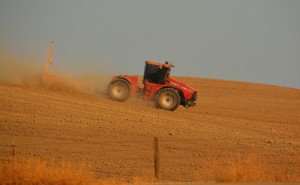
“So maybe this is not the time to start a new orchard,” said Stanislaus County’s Geologist, August 5, 2014.
In California, water has been “for fighting” since the founding of the state. That’s why it’s noteworthy when people agree on anything about it. But recently, there’s unanimity on one water fact statewide: Without surface water, nut farming in the foothills of the eastern San Joaquin Valley is not sustainable.
Why then are orchards going in faster than anyone can calculate? Even in the midst of today’s King Hell drought, Big Ag is ripping new orchard ground on Stanislaus County’s east side.
Keep in mind that there are already over thirty thousand acres of new nut trees out there, the vast majority solely dependent on groundwater. Keep in mind too that farmers on the Valley floor, even those in the water-wealthy Turlock and Modesto Irrigation Districts, have had their water allotments cut and are letting some crops die.
Farther down the Valley, farmers in the Westlands Water District are paying anywhere from $800 to $1100 an acre foot just to keep their crops alive. Consider that, then consider that farmers in the eastern foothills are pumping free water and as much as they want.
While the average onlooker might think anyone investing millions in unsustainable farming has to be batcrap crazy, don’t think for a millisecond eastside water miners don’t know what they’re doing. There’s a world of difference between sustainability and profitability, and the latter’s what counts for investors and speculators.
According to the Western Farm Press, today’s almond orchards can start showing profits as early as five years after planting. As almond prices keep soaring, the profits are phenomenal—as much as $3,000 an acre, and even more with free water.
Virtually every new orchard in the foothills of Stanislaus County is owned by players with more than enough money to ante up in today’s high stakes ag game, and these guys have worked the system brilliantly. Their hydrologists have told them how much water is in east side aquifers, their accountants have told them how many years they need to max out on profits, and their attorneys have told them groundwater is the last lawless frontier.
The result is hit-and-run ag. The object is to wring every last profitable drop out the aquifer and then bid “adios” to the horned toads and rattlesnakes in the desert you leave behind.
Ordinarily, there might be a little commotion about “externalities,” the costs to the public of depleting aquifers, diverting water from rivers, lakes, reservoirs, and streams, and leaving land unfit for anything but tumbleweed and reptiles. But in the San Joaquin Valley, there’s a long history of public accommodation of water miners, and taxpayers have always been more than willing to bear the burden of overdrafted aquifers and increasingly toxic soils.
Given the state’s antediluvian neglect of groundwater usage, and the region’s general willingness to be exploited, mining water in the foothills is a no-brainer. And anyone who wants to know the consequences of intense agriculture on thin topsoil with drainage problems need only look south, where it’s estimated 1.1 million persons will have toxic drinking water by 2050.
*An early version of our photo caption said the tractor was ripping ground. Thank you to the alert and informed reader who pointed out it is actually leveling ground. We appreciate the help.
